PhilomathInfodump BlogI study from different sources and remake them
Don't wanna be here? Send us removal request.
Text
Guitar Chords and Techniques Based on Difficulty Level
🎸 Beginner Level
Focuses on building finger strength, coordination, and basic strumming.
Chords:
Major Chords: C, G, D, A, E
Minor Chords: Am, Dm, Em
Dominant 7th Chords: G7, C7, D7
Suspended Chords: Asus2, Asus4, Dsus2, Dsus4
Techniques:
Basic Strumming Patterns
Downstrokes & Upstrokes
Chord Transitions
Palm Muting
Simple Arpeggios
Basic Fingerpicking
🎸 Intermediate Level
Introduces more complex chord shapes and refined playing techniques.
Chords:
Barre Chords: F, Bm, B
Major 7th Chords: Cmaj7, Gmaj7, Dmaj7
Minor 7th Chords: Am7, Dm7, Em7
Dominant 7th Chords: A7, E7, B7
Power Chords: F5, G5, A5
Techniques:
Barre Chords
Hammer-ons & Pull-offs
Slides
String Bending
Basic Soloing (Pentatonic Scale)
Travis Picking
🎸 Advanced Level
Requires precision, speed, and a deep understanding of guitar theory and technique.
Chords:
Extended Chords: C9, D9, G13
Diminished Chords: Bdim, C#dim
Augmented Chords: Caug, Gaug
Jazz Chords: Fmaj7#11, G7b9, D7#5
Complex Barre Shapes: F#m7b5, B7#9
Techniques:
Sweep Picking
Tapping
Harmonics (Natural & Artificial)
Legato Playing
Hybrid Picking
Fingerstyle Arrangements
Economy Picking
1 note
·
View note
Text
SHEET MUSIC GUIDE
Download PDF















3 notes
·
View notes
Text
Guide to Mental Disorders
1. Neurodevelopmental Disorders
Early-Onset, Cognitive/Behavioural Impairment
Intellectual Disability: Low IQ <70, Limited Problem-Solving, Adaptive Skills
Autism Spectrum Disorder: Social Communication Impairment, Repetitive Behaviours, Restricted Interests
ADHD: Inattention, Hyperactivity, Impulsivity, Impaired Functioning in Multiple Settings
Specific Learning Disorder: Persistent Academic Deficits, Reading, Writing, Math
Communication Disorders: Delayed Speech, Language Impairment, Speech Fluency Issues
Motor Disorders: Poor Coordination, Motor Tics, Developmental Coordination Disorder
2. Schizophrenia Spectrum and Other Psychotic Disorders
Psychotic Symptoms, Disconnected Reality
Schizophrenia: Delusions (False Beliefs), Hallucinations (False Perceptions), Disorganised Thinking, Social/Occupational Dysfunction
Schizoaffective Disorder: Psychotic Episodes + Mood Disorder (Depression/Mania)
Brief Psychotic Disorder: Acute Psychosis (usually triggered by stress), Short Duration (<1 month)
Delusional Disorder: Persistent Non-Bizarre Delusions (e.g., persecution or grandeur)
Substance-Induced Psychotic Disorder: Psychotic Symptoms Due to Substance Use (e.g., drugs, alcohol)
3. Bipolar and Related Disorders
Extreme Mood Swings
Bipolar I Disorder: Mania (elevated mood, energy) + Depressive Episodes
Bipolar II Disorder: Hypomania (milder mania) + Depression
Cyclothymic Disorder: Chronic Hypomania and Depression, Short Periods of Stability
Other Specified Bipolar Disorder: Bipolar-like Symptoms that Don't Fully Meet Criteria
4. Depressive Disorders
Persistent Sadness, Lack of Interest
Major Depressive Disorder: Depressed Mood, Anhedonia, Sleep and Appetite Changes, Worthlessness
Persistent Depressive Disorder (Dysthymia): Chronic Low Mood for 2+ Years, Less Severe Than Major Depression
Disruptive Mood Dysregulation Disorder: Severe Temper Outbursts, Irritable Mood in Children
Premenstrual Dysphoric Disorder: Severe PMS Symptoms, Mood Swings, Sleep Disruption
5. Anxiety Disorders
Excessive Worry/Fear, Avoidance
Generalised Anxiety Disorder: Chronic Worry, Muscle Tension, Fatigue, Restlessness
Panic Disorder: Recurrent Panic Attacks, Fear of Future Attacks
Agoraphobia: Fear of Open Spaces, Leaving Home, Being Trapped in Situations
Social Anxiety Disorder: Intense Fear of Being Judged or Embarrassed in Social Situations
Specific Phobias: Fear of Specific Objects or Situations (e.g., animals, heights, blood)
Separation Anxiety Disorder: Fear of Separation from Attachment Figures (e.g., parents)
6. Obsessive-Compulsive and Related Disorders
Obsessions + Compulsions, Repetitive Behaviours
Obsessive-Compulsive Disorder (OCD): Intrusive Thoughts (Obsessions) + Ritualistic Behaviours (Compulsions)
Body Dysmorphic Disorder: Obsession with Perceived Flaws in Appearance
Hoarding Disorder: Excessive Accumulation of Items, Distress About Discarding
Trichotillomania (Hair-Pulling Disorder): Recurrent Hair Pulling
Excoriation (Skin-Picking) Disorder: Compulsive Skin Picking, Tissue Damage
7. Trauma- and Stressor-Related Disorders
Trauma Exposure, Intrusive Thoughts
Post-Traumatic Stress Disorder (PTSD): Flashbacks, Nightmares, Avoidance, Hyperarousal
Acute Stress Disorder: Symptoms of PTSD but Lasting 3 Days to 4 Weeks
Adjustment Disorder: Emotional/Behavioural Response to Stressful Event
8. Dissociative Disorders
Disconnection from Reality, Identity, Memory
Dissociative Identity Disorder (DID): Presence of Two or More Distinct Identities or Personalities
Dissociative Amnesia: Memory Loss of Personal Information, Often Due to Trauma
Depersonalisation/Derealisation Disorder: Persistent Feelings of Detachment from Self or Surroundings
9. Somatic Symptom and Related Disorders
Physical Symptoms without Medical Cause
Somatic Symptom Disorder: Excessive Focus on Physical Symptoms, Impairment
Illness Anxiety Disorder: Preoccupation with Having or Acquiring a Serious Illness
Conversion Disorder: Neurological Symptoms (e.g., paralysis, blindness) with No Medical Explanation
Factitious Disorder: Falsifying Illness or Symptoms for Attention
10. Feeding and Eating Disorders
Disordered Eating Patterns
Anorexia Nervosa: Restrictive Eating, Fear of Weight Gain, Distorted Body Image
Bulimia Nervosa: Binge-Eating Episodes Followed by Compensatory Behaviours (e.g., vomiting)
Binge Eating Disorder: Recurrent Binge-Eating without Compensatory Behaviours
Pica: Eating Non-Food Substances (e.g., dirt, hair)
Rumination Disorder: Regurgitation of Food, Not Due to Medical Condition
11. Elimination Disorders
Inappropriate Urination/Defecation
Enuresis: Bedwetting Beyond Expected Age
Encopresis: Involuntary Defecation (often in clothes)
12. Sleep-Wake Disorders
Sleep Problems, Disturbances
Insomnia Disorder: Difficulty Falling or Staying Asleep
Narcolepsy: Excessive Daytime Sleepiness, Sleep Attacks
Sleep Apnoea: Breathing Stoppages during Sleep, Snoring
Parasomnias: Sleepwalking, Nightmares, Sleep Terrors
Circadian Rhythm Sleep-Wake Disorders: Disruption in Sleep Timing
13. Sexual Dysfunctions
Sexual Function, Desire, Arousal Issues
Erectile Disorder: Difficulty Achieving or Maintaining an Erection
Female Sexual Interest/Arousal Disorder: Low Interest or Arousal in Sexual Activity
Premature Ejaculation: Early Ejaculation During Intercourse
Delayed Ejaculation: Difficulty Achieving Orgasm
14. Gender Dysphoria
Mismatch Between Assigned and Experienced Gender
Gender Dysphoria: Strong Desire to Be of a Different Gender, Discomfort with Assigned Gender
15. Disruptive, Impulse-Control, and Conduct Disorders
Impulsive, Aggressive, Violent Behaviour
Conduct Disorder: Aggressive Acts (e.g., bullying), Rule Violations (e.g., stealing)
Oppositional Defiant Disorder: Defiant, Argumentative, Blaming Others
Intermittent Explosive Disorder: Sudden Aggressive Outbursts, Loss of Control
16. Substance-Related and Addictive Disorders
Addiction, Dependence, Withdrawal
Substance Use Disorder: Use Despite Harm, Withdrawal Symptoms
Substance Intoxication: Physical Symptoms (e.g., dizziness, nausea) Due to Drug Use
Substance Withdrawal: Physical/Emotional Symptoms Upon Stopping Drug Use
Gambling Disorder: Excessive Gambling, Risking Significant Losses
17. Neurocognitive Disorders
Memory, Cognitive Decline
Alzheimer’s Disease: Memory Loss, Language Impairment, Cognitive Decline
Vascular Dementia: Cognitive Decline Due to Stroke or Other Vascular Issues
Frontotemporal Dementia: Behavioural Changes, Personality Loss
Mild Neurocognitive Disorder: Early Stage Cognitive Decline, Difficulty with Daily Activities
Delirium: Acute Confusion, Memory Problems Due to Medical Conditions
18. Personality Disorders
Chronic Personality Traits, Dysfunctional Patterns
Borderline Personality Disorder: Impulsive, Emotional Instability, Fear of Abandonment
Antisocial Personality Disorder: Lack of Empathy, Disregard for Others' Rights
Narcissistic Personality Disorder: Grandiosity, Focus on Reputation, Lack of Empathy
Avoidant Personality Disorder: Extreme Social Inhibition, Fear of Rejection
Dependent Personality Disorder: Excessive Need to Be Taken Care of, Submissiveness
Obsessive-Compulsive Personality Disorder: Preoccupation with Order, Control, Perfectionism
19. Paraphilic Disorders
Atypical Sexual Interests
Pedophilic Disorder: Attraction to Prepubescent Children
Exhibitionistic Disorder: Exposure of Genitals to Unwilling Strangers
Frotteuristic Disorder: Rubbing against Non-consenting Individuals
20. Other Mental Disorders
Non-specific Disorders
Other Specified Mental Disorder: Symptoms Not Fully Meeting a Specific Diagnosis
Unspecified Mental Disorder: Symptoms Present but Not Fully Defined
21. Medication-Induced Movement Disorders
Movement Side Effects of Medication
Tardive Dyskinesia: Involuntary Facial and Body Movements (due to antipsychotics)
Neuroleptic Malignant Syndrome: Fever, Muscle Rigidity, Autonomic Dysregulation (due to antipsychotics)
Medication-Induced Parkinsonism: Parkinson's-like Symptoms (tremors, rigidity)
22. Other Conditions that may be Focus of Clinical Attention
External Factors Impacting Mental Health
Relational Problems: Issues in Family, Couples, or Social Relationships
Occupational/Workplace Issues: Work Stress, Burnout
6 notes
·
View notes
Text
German Language : 30 Days Learning Plan
Week 1: Foundation (Days 1-7)
Day 1:
Morning:
15 minutes: Learn basic greetings (Guten Morgen, Guten Tag, etc.) and introductions (Ich heiße...).
15 minutes: Learn numbers 1-20.
15 minutes: Basic pronunciation practice (focus on vowels).
Afternoon:
15 minutes: Listen to a short German children's song.
15 minutes: Flashcards: Review greetings, introductions, and numbers.
Day 2:
Morning:
15 minutes: Learn colors (rot, blau, grün).
15 minutes: Learn days of the week (Montag, Dienstag...).
15 minutes: Pronunciation: Focus on consonant sounds (b, d, t).
Afternoon:
15 minutes: Listen to a simple German conversation.
15 minutes: Flashcards: Review colors and days of the week.
Day 3:
Morning:
15 minutes: Learn basic phrases (Danke, Bitte, Entschuldigung).
15 minutes: Learn family members (Mutter, Vater, Bruder).
15 minutes: Pronunciation: Focus on common word endings (-en, -er).
Afternoon:
15 minutes: Read a short, simple text (e.g., a children's story).
15 minutes: Flashcards: Review phrases and family members.
Day 4:
Morning:
15 minutes: Learn basic food vocabulary (Brot, Milch, Obst).
15 minutes: Learn simple sentence structures (Ich habe..., Ich esse...).
15 minutes: Pronunciation: Practice sentence intonation.
Afternoon:
15 minutes: Listen to a German song with simple lyrics.
15 minutes: Write simple sentences using learned vocabulary.
Day 5:
Morning:
15 minutes: Review all vocabulary learned this week.
15 minutes: Play a simple German word game (e.g., memory game).
15 minutes: Pronunciation: Focus on any sounds that are challenging.
Afternoon:
15 minutes: Listen to a German audiobook for beginners.
15 minutes: Write a short paragraph about yourself in German.
Day 6:
Morning:
15 minutes: Review greetings, introductions, and numbers.
15 minutes: Learn a simple German song.
15 minutes: Pronunciation: Practice with a language exchange partner (online or in person).
Afternoon:
15 minutes: Watch a short German video clip with subtitles.
15 minutes: Flashcards: Review all vocabulary learned this week.
Day 7:
Morning:
15 minutes: Review all vocabulary and phrases learned in Week 1.
15 minutes: Play a simple German board game.
15 minutes: Pronunciation: Focus on improving overall fluency.
Afternoon:
15 minutes: Read a short, easy German story.
15 minutes: Write a short conversation using learned phrases.
Week 2: Building Blocks (Days 8-14)
Day 8:
Morning:
20 minutes: Learn 10 new nouns with articles (der, die, das).
20 minutes: Study basic word order in German sentences.
10 minutes: Practice sentence construction with the new vocabulary.
Afternoon:
20 minutes: Read a short German text about a familiar topic.
10 minutes: Write a few sentences about your daily routine.
Day 9:
Morning:
20 minutes: Learn 10 new verbs (common actions: essen, trinken, gehen).
20 minutes: Practice verb conjugations in the present tense (Ich esse, Du isst...).
10 minutes: Create short dialogues using the new verbs.
Afternoon:
20 minutes: Listen to a German news report for beginners.
10 minutes: Write a short dialogue about a simple situation.
Day 10:
Morning:
20 minutes: Learn 10 new adjectives (gut, schön, groß).
20 minutes: Practice using adjectives to describe people and things.
10 minutes: Create sentences using adjectives and nouns.
Afternoon:
20 minutes: Read a short German story with simple adjectives.
10 minutes: Write a short description of a person or place.
Day 11:
Morning:
20 minutes: Review all vocabulary learned this week.
20 minutes: Play a German word association game.
10 minutes: Pronunciation: Focus on the correct pronunciation of articles.
Afternoon:
20 minutes: Listen to a German podcast for beginners.
10 minutes: Write a short paragraph using learned vocabulary and grammar.
Day 12:
Morning:
20 minutes: Review noun genders and articles.
20 minutes: Practice using the present tense of verbs with different pronouns.
10 minutes: Create short dialogues using different verb forms.
Afternoon:
20 minutes: Read a short German article from a beginner's website.
10 minutes: Write a short email in German to a friend.
Day 13:
Morning:
20 minutes: Review adjectives and their usage.
20 minutes: Practice using adjectives to compare things (größer, kleiner).
10 minutes: Create sentences using comparative adjectives.
Afternoon:
20 minutes: Watch a short German cartoon.
10 minutes: Write a short story using learned vocabulary and grammar.
Day 14:
Morning:
20 minutes: Review all vocabulary and grammar learned in Week 2.
20 minutes: Play a German board game that involves vocabulary and grammar.
10 minutes: Pronunciation: Focus on improving fluency and intonation.
Afternoon:
20 minutes: Read a short German story.
10 minutes: Summarize the story in your own words in German.
Week 3: Communication (Days 15-21)
Day 15:
Morning:
25 minutes: Practice a simple conversation with a language partner or using a language exchange app.
15 minutes: Watch a short German video clip with subtitles.
10 minutes: Focus on improving pronunciation and intonation.
Afternoon:
20 minutes: Write a short paragraph in German about a familiar topic.
10 minutes: Review and correct any mistakes in your writing.
Day 16:
Morning:
25 minutes: Role-play a simple conversation (e.g., ordering food, asking for directions).
15 minutes: Listen to a German interview.
10 minutes: Focus on understanding spoken German.
Afternoon:
20 minutes: Write a short letter in German to a friend or family member.
10 minutes: Review and correct any mistakes in your writing.
Day 17:
Morning:
25 minutes: Practice introducing yourself and talking about your hobbies.
15 minutes: Watch a short German movie clip with subtitles.
10 minutes: Focus on understanding the cultural context of the video.
Afternoon:
20 minutes: Write a short story about a personal experience.
10 minutes: Review and correct any mistakes in your writing.
Week 3: Communication (Days 15-21)
Day 18:
Morning:
25 minutes: Review all conversation topics practiced this week.
15 minutes: Play a German card game that involves communication.
10 minutes: Pronunciation: Focus on improving fluency and natural speech patterns.
Afternoon:
20 minutes: Listen to a German podcast about a topic that interests you.
10 minutes: Summarize the podcast in your own words in German.
Day 19:
Morning:
25 minutes: Practice ordering food at a restaurant in German.
15 minutes: Watch a short German documentary with subtitles.
10 minutes: Focus on understanding the vocabulary related to the topic.
Afternoon:
20 minutes: Write a short email in German to a German-speaking friend.
10 minutes: Review and correct any mistakes in your writing.
Day 20:
Morning:
25 minutes: Practice giving and understanding directions in German.
15 minutes: Listen to a German song and try to understand the lyrics.
10 minutes: Focus on improving your listening comprehension skills.
Afternoon:
20 minutes: Write a short story about a fictional trip to Germany.
10 minutes: Review and correct any mistakes in your writing.
Day 21:
Morning:
25 minutes: Review all communication skills practiced this week.
15 minutes: Have a short conversation with a language partner, focusing on fluency and natural conversation.
10 minutes: Pronunciation: Focus on improving your overall fluency and intonation.
Afternoon:
20 minutes: Read a short German article about a current event.
10 minutes: Summarize the article in your own words in German.
Week 4: Immersion & Advancements (Days 22-28)
Day 22:
Morning:
30 minutes: Listen to a German podcast or radio program without subtitles.
20 minutes: Learn the present perfect tense of common verbs.
10 minutes: Practice using the present perfect tense in sentences.
Afternoon:
25 minutes: Read a slightly more challenging German text.
15 minutes: Write a short story using the present perfect tense.
Day 23:
Morning:
30 minutes: Watch a short German movie clip without subtitles.
20 minutes: Learn the past simple tense of common verbs.
10 minutes: Practice using the past simple tense in sentences.
Afternoon:
25 minutes: Read a short German article about German history or culture.
15 minutes: Write a short paragraph summarizing the article.
Day 24:
Morning:
30 minutes: Listen to a German audiobook for beginners.
20 minutes: Review the present perfect and past simple tenses.
10 minutes: Create short dialogues using both tenses.
Afternoon:
25 minutes: Read a short German novel or short story.
15 minutes: Write a short summary of the reading.
Day 25:
Morning:
30 minutes: Immerse yourself in German by listening to German music.
20 minutes: Learn basic modal verbs (können, m��ssen, wollen).
10 minutes: Practice using modal verbs in sentences.
Afternoon:
25 minutes: Write a short essay in German about a topic that interests you.
15 minutes: Review and correct any mistakes in your writing.
Day 26:
Morning:
30 minutes: Review all grammar concepts learned this week.
20 minutes: Play a German word game that focuses on grammar.
10 minutes: Pronunciation: Pay attention to the pronunciation of verb endings.
Afternoon:
25 minutes: Read a German newspaper article (online or in print).
15 minutes: Summarize the main points of the article in German.
Day 27:
Morning:
30 minutes: Immerse yourself in German by watching a German TV show.
20 minutes: Review modal verbs and practice using them in different contexts.
10 minutes: Create a short dialogue using modal verbs.
Afternoon:
25 minutes: Write a short letter to a German-speaking company or organization.
15 minutes: Review and correct any mistakes in your writing.
Day 28:
Morning:
30 minutes: Review all vocabulary and grammar learned in Week 4.
20 minutes: Practice a conversation with a language partner, focusing on more advanced topics.
10 minutes: Pronunciation: Pay attention to the rhythm and intonation of spoken German.
Afternoon:
25 minutes: Read a short German story or poem.
15 minutes: Analyze the literary devices used in the text.
Week 5: Consolidation & Assessment (Days 29-30)
Day 29:
Morning:
45 minutes: Review all vocabulary learned throughout the month.
30 minutes: Review key grammar concepts (noun genders, articles, verb conjugations, tenses, modal verbs).
15 minutes: Practice a conversation with a language partner, focusing on fluency and accuracy.
Afternoon:
30 minutes: Write a short essay summarizing your language learning journey.
15 minutes: Reflect on your progress and identify areas for improvement.
Day 30:
Morning:
60 minutes: Take a short self-assessment quiz to evaluate your progress.
30 minutes: Review the quiz results and identify areas that need further study.
Afternoon:
30 minutes: Reflect on your learning journey and set goals for continued German language learning.
1 note
·
View note
Text
Psychopathology
CONTENT LIST 1. Definition 2. Significance in Mental Health 3. Models of Psychopathology 4. Factors Contributing to Psychopathology PSYCHOPATHOLOGY : The Handbook (work-in-progress) For information regarding mental disorders.
--
Definition :
Psychopathology is the study of mental disorders, including their causes, symptoms, diagnosis, and treatment. It is a branch of psychology that focuses on the scientific study of abnormal thoughts, feelings, and behaviours associated with mental illness.
Psychopathology involves the examination of various aspects of mental disorders, including :
Etiology : The study of the causes and risk factors of mental disorders.
Symptomology : The study of the symptoms and characteristics of mental disorders.
Diagnosis : The process of identifying and classifying mental disorders.
Assessment : The evaluation of an individual's mental health and functioning.
Treatment : The development and implementation of interventions to alleviate symptoms and improve functioning.
Psychopathology is an interdisciplinary field that draws on knowledge from psychology, psychiatry, neuroscience, sociology, and philosophy. It is concerned with understanding the biological, psychological, and social factors that contribute to mental disorders, as well as the development of effective treatments and interventions.
--
Significance in Mental Health
Psychopathology plays a crucial role in mental health by providing a framework for understanding, diagnosing, and treating mental disorders. Here are some significance of psychopathology in mental health :
Accurate Diagnosis : Psychopathology helps mental health professionals diagnose mental disorders accurately, which is essential for developing effective treatment plans.
Development of Treatment Plans : Understanding the underlying causes and symptoms of mental disorders enables mental health professionals to develop targeted treatment plans, including psychotherapy and medication.
Research and Development : Psychopathology informs research on mental health, leading to the development of new treatments, interventions, and prevention strategies.
Improved Patient Outcomes: By understanding the complexities of mental disorders, mental health professionals can provide more effective care, leading to better patient outcomes and improved quality of life.
Reducing Stigma : Psychopathology helps to reduce stigma associated with mental illness by promoting a scientific understanding of mental disorders and encouraging empathy and compassion.
Early Intervention : Psychopathology enables early identification and intervention, which can prevent the progression of mental disorders and reduce the risk of complications.
Personalised Care : By understanding the unique characteristics of each mental disorder, mental health professionals can provide personalised care tailored to an individual's specific needs.
Public Health Policy : Psychopathology informs public health policy, guiding the allocation of resources and development of programmes to address mental health needs.
Education and Training : Psychopathology provides a foundation for education and training in mental health, ensuring that mental health professionals have the necessary knowledge and skills to provide high-quality care.
Advancements in Neuroscience : Psychopathology contributes to advancements in neuroscience, leading to a better understanding of the neural mechanisms underlying mental disorders.
Some of the key applications of psychopathology in mental health include :
Clinical Psychology : Psychopathology is essential for clinical psychologists, who use it to diagnose and treat mental disorders.
Psychiatry : Psychiatrists use psychopathology to develop treatment plans, including medication and therapy.
Counseling : Counselors use psychopathology to understand the underlying causes of mental health issues and develop targeted interventions.
Research : Researchers use psychopathology to study mental health, develop new treatments, and improve existing ones.
--
Models of Psychopathology :
Descriptive The use of DSM-V and ICD-10 as the basis to describe characteristics and symptoms of mental disorders
Explanatory Identification of the causes of mental disorders through various explanations of the subject's aspects of life. - Biological Genetics, neurochemistry, and brain structure. - Psychodynamic Unconscious thoughts, feelings, and experiences. - Cognitive-Behavioural Negative thought patterns and behaviours. - Humanistic A lack of self-actualisation and self-growth. - Sociocultural Poverty, racism, and social inequality. - Multi-Dimensional Combination of 2 or more of explanatory models.
--
Factors Contributing to Psychopathology
Multiple factors contribute to psychopathology, and it's often a complex interplay of biological, psychological, social, and environmental factors. Here are some of the key factors that can contribute to psychopathology :
Biological Factors :
Genetics : Genetic predisposition can play a role in the development of mental disorders, such as schizophrenia, bipolar disorder, and depression.
Neurotransmitters : Imbalances or abnormalities in neurotransmitters like serotonin (learning, memory, happiness as well as regulating body temperature, sleep, sexual behaviour and hunger), dopamine (pleasure, satisfaction and motivation), and norepinephrine (regulation of arousal, attention, cognitive function, and stress reactions) can contribute to mental disorders.
Brain Structure : Abnormalities in brain structure, such as reduced hippocampal volume (memory, learning, and emotion), can be associated with mental disorders like depression and anxiety.
Infections and Inflammation : Certain infections, such as toxoplasmosis, and chronic inflammation have been linked to an increased risk of mental disorders.
Psychological Factors :
Trauma : Experiencing traumatic events, such as childhood abuse or neglect, can increase the risk of developing mental disorders like PTSD and depression.
Personality Traits : Certain personality traits, like neuroticism, can increase the risk of developing mental disorders.
Cognitive Styles : Negative thought patterns, such as rumination and catastrophising, can contribute to mental disorders like depression and anxiety.
Learning and Conditioning : Learning and conditioning processes, such as classical conditioning (unconscious/automatic learning method by Pavlov), can contribute to the development of mental disorders like phobias.
Social Factors :
Family Dynamics : Dysfunctional family dynamics, such as parental conflict or neglect, can increase the risk of developing mental disorders.
Social Support : Lack of social support or social isolation can contribute to mental disorders like depression and anxiety.
Cultural and Societal Factors : Cultural and societal factors, such as discrimination and poverty, can increase the risk of developing mental disorders.
Life Events : Significant life events, such as divorce or job loss, can trigger mental disorders like depression and anxiety.
Environmental Factors :
Prenatal and Perinatal Factors : Prenatal and perinatal factors, such as maternal stress and prenatal nutrition, can influence the development of mental disorders.
Toxins and Pollutants : Exposure to toxins and pollutants, such as lead and pesticides, has been linked to an increased risk of mental disorders.
Nutrition and Gut Health: Poor nutrition and gut health have been linked to an increased risk of mental disorders like depression and anxiety.
Sleep and Circadian Rhythms : Disruptions to sleep and circadian rhythms can contribute to mental disorders like depression and bipolar disorder.
Interplay between Factors :
Gene-Environment Interaction : The interplay between genetic and environmental factors can influence the development of mental disorders.
Epigenetics : Epigenetic changes, which affect gene expression, can be influenced by environmental factors and contribute to mental disorders.
Complexity and Multi-Finality : Mental disorders often result from the complex interplay of multiple factors, and a single factor can contribute to multiple mental disorders.
1 note
·
View note
Text
The Narcissists
Source : Poor Narcissus. By Darlene Lancer, LMFT
--
The gods sentenced him to a life without human love. He fell in love with his own reflection in pool of water and died hungering for its response. Like Narcissus, narcissists only love themselves as reflected in the eyes of others. It’s a common misconception that they love themselves. They actually dislike themselves immensely. Their inflated self-flattery, perfectionism, and arrogance are merely covers for the self-loathing they don’t admit–usually even to themselves. Instead, it’s projected outwards in their disdain for and criticism of others. They’re too afraid to look at themselves, because they believe that the truth would be devastating. Actually, they don’t have much of a Self at all. Emotionally, they’re dead inside and they hunger to be filled and validated by others. Sadly, they’re unable to appreciate the love they do get and alienate those who give it.
Narcissists are often mistaken for loving themselves, but they actually harbour deep self-loathing. Their outward arrogance and perfectionism are masks for this inner disdain. They depend on others for validation, yet are emotionally empty and unable to appreciate the love they receive, ultimately alienating those around them.
--
Diagnosis
All personality traits, including narcissism, range from mild to severe. Narcissism can be viewed on a continuum from mature to archaic. Mature individuals are able to idealize romantic partners, express their talents and skills, and accomplish their goals, while employing only neurotic defenses; a middle group has unstable boundaries and employ borderline defenses; and those highly sensitive to wounding, employ destructive, psychotic defenses and have unstable relationships (Solomon, 1989). Narcissistic Personality Disorder (NPD), first categorized as a disorder by the American Psychiatric Association in 1987, occurs in 1 to 6.2 percent of the population; males exceed females at a ratio of 3:2 (Dhawan, 2010; McClean, 2007). Although nonprofessionals often label people with NPD who show a few narcissistic traits, clinical NPD ranges in severity from those with only the minimum required five diagnostic traits to narcissists who strongly manifest all nine symptoms. Here’s a summary of the Diagnostic Criteria in the DSM-5: Someone with a pervasive pattern of grandiosity (sometimes only in fantasy), need for admiration from others, and lack of empathy, beginning in childhood, as indicated by five of these characteristics: 1. Has a grandiose sense of self-importance and exaggerates achievements and talents 2. Dreams of unlimited power, success, brilliance, beauty, or ideal love 3. Believes he or she is special and unique, and can only be understood by, or should associate with, other special or high-status people or institutions 4. Requires excessive admiration 5. Unreasonably expects special, favorable treatment or compliance with his or her wishes 6. Exploits and takes advantage of others to achieve personal ends 7. Lacks empathy for the feelings and needs of others 8. Envies others or believes they’re envious of him or her 9. Has arrogant behaviors or attitudes In addition to the grandiose “Exhibitionist Narcissist” described above, James Masterson identifies a “Closet Narcissist”–someone with a deflated, inadequate self-perception, a sense of depression and inner emptiness. He or she may appear shy, humble or anxious, because his or her emotional investment is in the idealized other, which is indirectly gratifying (Masterson, 2004). “Malignant” narcissists are the most pernicious and hostile, enacting anti-social behavior. They can be cruel and vindictive when they feel threatened or don’t get what they want.
Narcissism exists on a spectrum from mild to severe. While mature narcissists can idealize partners and achieve goals, those with severe narcissism exhibit destructive behaviors and unstable relationships.
Different types of narcissists include exhibitionists who seek admiration, closet narcissists who feel inadequate, and malignant narcissists who exhibit hostile, anti-social behavior.
--
Early Beginnings
It’s hard to empathize with narcissists, but they didn’t choose to be that way. Their natural development was arrested due to faulty, early parenting, usually by a mother who didn’t provide sufficient nurturing and opportunity for idealization. Some believe the cause lies in extreme closeness with an indulgent mother, while others attribute it to parental harshness or criticalness. This latter position stems from Otto Kernberg’s emphasis on parental anger, envy, and hate, or indifference that expresses veiled aggression. (Ellis, 2009; Russell, 1985) The two views converge on the underlying psychodynamics. An idealizing, indulgent mother may be unable to experience her child as a separate individual and provide sufficient empathy, mirroring, or opportunity for idealization. Although leniency can result in healthy narcissism, when psychological control is added, like guilt induction and withdrawal of love, a solid self doesn’t develop, because the child’s focus is to gain external approval. Rather than receiving support for an emerging autonomous self, the child learns that love and involvement is conditioned on conforming to parental needs and expectations. (Horton, Bleau, & Drwecki, 2006) Heinz Kohut observed this in his narcissistic clients who suffered from profound alienation, emptiness, powerlessness, and lack of meaning. Beneath a narcissistic façade, they lacked sufficient internal structures to maintain cohesiveness, stability, and a positive self-image to provide a stable identity. (Russell, 1985) He believed the cause lay in the empathic failure between the caregiver and child. He differed from Otto Kernberg, who thought the pathology began during the oral stage, claiming that it could even begin in latency. Narcissists are uncertain of the boundaries between themselves and others and vacillate between dissociated states of self-inflation and inferiority. This diagram illustrates how a self divided by shame is made up of the superior-acting, grandiose self and the inferior, devalued self:

1. When the devalued self is in the inferior position, shame manifests by idealizing others. 2. When the individual is in superior position, defending against shame, the grandiose self aligns with the inner critic and devalues others through projection. Both devaluation and idealization are commensurate with the severity of shame and the associated depression (Lancer, 2014). Although most people fluctuate in these positions, the Exhibitionistic and Closet Narcissists are more or less static in their respective superior and inferior positions irrespective of reality, making them pathological. Arrogance, denial, projection, envy, and rage are among the defenses to shame (Lancer, 2014). Narcissists defend against shame and fragmentation by feeling special through idealizing (idealizing transference) or identifying with (mirror transference) others. Understanding the dynamics of projective-identification of these states is key in working with transference and countertransference (Lancer, 2013). Although more research is required, twin studies revealed a 54-percent correlation of narcissistic behaviors, suggesting a genetic component (Livesley, Jang, Jackson, & Vernon, 1993).
Narcissism often stems from early developmental issues, typically due to insufficient nurturing or overly critical parenting. This leads to an unstable self-image and a reliance on external approval. Narcissists experience profound emptiness and struggle with boundaries, alternating between grandiosity and inferiority. They defend against shame by feeling special, either by idealising or identifying with others. Understanding these dynamics is key to addressing their behaviors.
It's important to recognise that narcissists didn't choose their condition; it's rooted in their early experiences. This understanding can foster empathy and guide more effective ways to support them.
--
Relationships with Narcissists
It’s easy to fall in love with narcissists. Their charm, talent, success, beauty, and charisma cast a spell, along with compliments, scintillating conversation, and even apparent interest in others. Enlivened by their energy, people gravitate towards them and are proud to bask in their glow. The Narcissist. At home, narcissists are totally different than their public persona. They may privately denigrate the person they were just entertaining. After an initial romance, they expect appreciation of their specialness and specific responses through demands and criticism in order to manage their internal environment and protect against their high sensitivity to humiliation and shame. Relationships revolve around them, and they experience their mates as extensions of themselves. Most narcissists are perfectionists. Nothing others do is right or appreciated. Their partners are expected to meet their endless needs when needed – for admiration, service, love, or purchases – and are dismissed when not. That their spouse is ill or in pain is inconsequential. Narcissists don’t like to hear “No” and often expect others to know their needs without having to ask. They manipulate to get their way and punish or make partners feel guilty for turning them down. Trying to please the narcissist is thankless, like trying to fill a bottomless pit. They can make their partners experience what it was like having had a cold, invasive, or unavailable narcissistic parent. Anne Rice’s vampire Lestat had such an emotionally empty mother, who devotedly bonded with him to survive. The deprivation of real nurturing and lack of boundaries make narcissists dependent on others to feed their insatiable need for validation. The Narcissist’s Partner. Although their partners feel loved when the narcissist bestows caring words and gestures, is madly possessive, or buys expensive gifts, they doubt his or her sincerity and question whether it’s really manipulation, pretense, or a manufactured “as if” personality. They feel tense and drained from unpredictable tantrums, attacks, false accusations, criticism, and unjustified indignation about small or imaginary slights. These partners also lack boundaries and absorb whatever is said about them as truth. In vain attempts to win approval and stay connected, they sacrifice their needs and thread on eggshells, fearful of displeasing the narcissist. They daily risk blame and punishment, love being withheld, or a rupture in the relationship. They worry what their spouses will think or do, and become as pre-occupied with the narcissist as they are with themselves. Partners have to fit in to the narcissists’ cold world and get used to living with emotional abandonment. Soon, they begin to doubt themselves and lose confidence and self-worth. Communicating their disappointment gets twisted and is met with defensive blame or further put downs. The narcissist can dish it, but not take it. Nevertheless, they stay, because periodically the charm, excitement, and loving gestures that first enchanted them return, especially when the narcissist feels threatened that a break-up is imminent. When two narcissists get together, they fight over whose needs come first, blame, and push each other away, yet are miserable needing each other.
Narcissists often captivate others with their charm and charisma, but their true nature surfaces in close relationships, where they become demanding, critical, and manipulative. Their partners are left feeling drained and unappreciated, constantly striving to meet impossible standards. Despite the emotional toll, many partners stay, hoping for the occasional return of the initial charm.
Narcissists can be incredibly captivating at first, making it easy to fall for them. However, their true nature often leads to toxic and draining relationships. It's crucial to recognise the signs early and set healthy boundaries to protect one's emotional well-being.
--
Codependency
Despite having a seemingly strong personality, narcissists lack a core self. Their self-image and thinking and behavior are other-oriented in order to stabilize and validate their self-esteem and fragile, fragmented self. They share codependent core symptoms of denial, control, shame, dependency (unconscious), and dysfunctional communication and boundaries, all leading to intimacy problems. One study showed a significant correlation between narcissism and codependency (Irwin, 1995). Although more aggressive than passive, in my opinion, they are codependent. Accommodating codependents and narcissists can be a perfect fit, albeit painful, because the latter’s attributes and aura of success boost the formers’ low self-esteem, which allows accommodators to tolerate emotional abuse. Typically, accommodators aren’t authoritative and prefer a nonassertive, subordinate role, because their own power and often anger are repressed, frightening, and shamebound. They seek and hunger for missing parts of themselves and idealize new partners’ qualities, which they hope to absorb. This is why two accommodators rarely get together. They’re in awe of narcissists’ self-direction and “strength,” and live vicariously in the reflection of their success, power, protection, and charisma, while unaware of narcissists’ fragile personas and hidden shame (Lancer, 2014). Accommodators attach to narcissists who appear bold and express their needs and anger, yet themselves feel needless and suffer guilt when they assert themselves. Caretaking and pleasing make codependents feel valued. Because they feel undeserving of receiving love, they don’t expect to be loved for who they are–only for what they give or do (Lancer, 2014). Narcissists are also drawn to their opposite to support their pride and fill their emptiness–partners who are emotionally expressive and nurturing, qualities they lack. They need partners they can control who won’t challenge them and make them feel weak (Lancer, 2014). Often in these relationships, narcissists are the distancers when more than sex is anticipated. Getting emotionally close means giving up power and control. The thought of being dependent is abhorrent. It not only limits their options and makes them feel weak, but also exposes them to rejection and feelings of shame, which they keep from consciousness at all costs. (Lancer, 2014) Their anxious partners pursue them, unconsciously replaying emotional abandonment from their past. Underneath they both feel unlovable.
Narcissists' lack of a core self and their constant need for validation through others' admiration and attention create complex dynamics in relationships. They often attract and maintain relationships with accommodating individuals who are drawn to their perceived strength and success. This dynamic, while appearing to meet some needs initially, often leads to emotional abuse and a skewed power balance where the narcissist's needs dominate.
The codependent nature of these relationships, where one party accommodates the other's demands at the expense of their own well-being, can be deeply damaging. It's important for individuals in such relationships to recognise their own value and set boundaries to protect their emotional health. Understanding these dynamics can help break the cycle of seeking validation from others who may not be capable of providing genuine love or support.
--
Treatment
Narcissists comprise only 2-16 percent of clients and don’t often come to individual therapy (McClean, October, 2007). They see the cause of their problems as external due to their defenses of denial, distortion, and projection, which limit their ability for introspection. Thus, they usually enter treatment to manage an external problem, such as a divorce or work-related issue, or following a major blow to their fragile self. Sometimes they come because their spouse insisted on conjoint counseling, and occasionally, they seek treatment for loneliness and depression. Medication has not been shown to be effective, except to treat associated depression.
The fact that narcissists rarely seek therapy on their own highlights the profound challenges in addressing their issues. Their reliance on defenses like denial, distortion, and projection makes introspection and personal growth difficult. When they do seek therapy, it's often due to external pressures or crises, rather than a genuine desire for self-improvement. This resistance to therapy not only hampers their own development but also affects those around them who suffer from their behavior.
It underscores the importance of supportive yet firm therapeutic approaches that can gradually break through these defenses. However, it also emphasises the need for those in relationships with narcissists to set clear boundaries and seek their own support, as waiting for the narcissist to change can be a long and uncertain process.
--
Individual Therapy
Many therapists believe depth work should be avoided not only because the narcissist’s difficulties are felt as ego-syntonic, but also because they need to strengthen their defenses against primitive feelings (Russell, 1985). One client who entered therapy during a tumultuous divorce soon quit. He claimed that self-examination lowered his self-esteem and that he needed a drink to get through each session. He resented the analyst’s fees as exploitative, “typical of women,” including his soon to be ex-wife. Although narcissism is difficult to treat, progress can be made over time. Weekly sessions over a shorter term can improve patients’ functioning and adaptation to reality by gaining some control over their defenses and by working through some past traumata (Masterson, 2004). They can learn to manage their anger, rage, and impulsivity, and although narcissists may feign empathy in order to get close or win others’ approval, subclinical narcissists (without full-blown NPD) have been taught empathy, through using their imagination (put themselves in another’s shoes) (Hepper, Hart, & Sedikides, 2014). Similarly, narcissists may be philanthropists or volunteers in the community for the public approbation they receive to boost their self-esteem, but they can learn to empathize and be less self-centered by helping others without personal gain. Psychoanalysis and psychoanalytic psychotherapy are generally used for treating the disorder itself. Treatment of two or more times per week centers on activating the patient’s grandiose self through empathic mirroring until “transmuting internalization” occurs, creating internal psychic structures. The patient may also develop an idealizing transference, attributing perfection to the analyst, in order to use him or her for stability, calmness, and comfort (Russell, 1985). In comparing Kohut and Carl Rogers, Robert Stolorow described the therapist’s empathic stance in client-centered therapy: “The client thus comes to experience himself as ‘prized’ . . . by the therapist, much as does the narcissistically disturbed patient immersed in a mirror transference” (Stolorow, 1976, p. 29). Quoting Rogers, Stolorow adds: “The therapist endeavours to keep himself out as a separate person . . . his whole endeavour is to understand the other so completely that he becomes almost an alter ego of the client . . . The whole relationship is composed of the self of the client, the counselor being depersonalized for the purposes of therapy into being ‘the client's other self.’ (Rogers, 1951, pp. 42, 208) ” Kohut believed that the analyst should neither interpret transferences, nor defenses, including rage at the analyst who fails to live up to the patient’s expectations or satisfy his or her needs. Instead, the clinician should allow and echo the patient’s “emerging grandiose fantasies of self-glorification, especially the wish to feel special to and admired by the analyst” (parent), which was missed in childhood. (Russell, 1985, p. 146) Kohut argued that interpreting the transference and confronting clients’ defenses risk being experienced as deeply wounding. This may cause more defensiveness and suppress the transference necessary for transmutation. Kernberg also recommends a supportive, empathic approach, but in contrast maintains that both positive and negative aspects of the transference should be interpreted; rage in treatment must be confronted in order to preserve the therapy and contain patients’ fears of destroying it and any hope of receiving love (Russell, 1985). Masterson employs a “mirroring interpretation of narcissistic vulnerability” only when the patient is acting-out in the transference. It’s a three-step process to interrupt narcissistic defenses in order to bring to the surface the patient’s underlying painful affect (Masterson, 2004).
1. Identify and acknowledge the patient’s painful affect with empathy and understanding. 2. Emphasize the impact on the patient’s self to indicate understanding of his or her experience. 3. Identify and explain the defense or resistance, which can be tied to step 1, by observing how it protects, calms, and soothes the patient from experiencing the painful affect. Care must be taken to avoid a narcissistic injury.
Ideally, interpretations focus on the patient’s need to restore strength after feeling injured. With a grandiose narcissist, the therapist focuses on the failure to mirror the patient’s grandiose self. With a Closet Narcissist, the therapist focuses on failures in the idealized object (Masterson, 2004). Over time, continued mirroring and working through manageable disturbances in the therapy build trust in the therapist, so that the patient is now better able to participate in self-reflection and tolerate and ingest interpretations (McClean, 2007). Other therapies for treating narcissism include transference-focused therapy and Jeffrey Young’s Schema Therapy, which integrates psychodynamic, cognitive, and behavioral approaches. Stephen M. Johnson also advocates an integrative strategy to include affective therapies, such as Gestalt, Reichian, and bio-energetics. Conjoint Therapy. The goals of conjoint therapy are that partners attain more realistic and empathic object representations of one another and can tolerate each other’s failure to meet their self-object needs (transmuting internalization) (Solomon, 1989). Underlying vulnerability and shame can provoke escalating cycles of defensive maneuvers involving forms of attack and withdrawal (Lancer, 2014). Destructive defensives further deteriorate representations of one another and make therapy unsafe. Couples can be educated that such tactics erode good feelings and damage their relationship. To build self-awareness and mutual empathy, the therapist can ask them to each talk about how they protect themselves when they’re hurt, what they need and want from each other, and the effects of their current strategies. This can open an empathic dialogue between them about feelings, wishes, and needs, the way communicate, and its impact on one another. When a defense is employed, the therapist should interrupt the issues at hand, stating something like, “I think we’re getting to the heart of something that hurts you both a great deal” (Solomon, 1989, p. 159). Then he or she can mirror the underlying hurt, emotions, and needs as suggested by Masterson, above, and guide the partner to assertively express them in a nonthreatening way. Connecting the couple’s pain to their individual past provides space between them and mutual empathy. It allows projections to be detoxified, retrieved by the projector, and not taken personally by the recipient. They also need help to take responsibility for their individual self-soothing and finding other means of support for their needs. When narcissists won’t join counseling, their partners may enter individual therapy. The therapist can help the partner de-idealize his or her spouse and build self-esteem, autonomy, and resources outside the relationship. By connecting the client’s yearnings and pain to childhood abandonment depression, past trauma and shame can be worked through to increase self-worth and self-compassion. Supporting the partner to assertively ask the narcissist for what the client wants and to stop reacting to the narcissist and set boundaries, empowers the client and builds self-esteem. It also reduces denial and awakens the client to the reality of the narcissist’s limitations. Intervening this way intrapsychically and systemically in individual therapy often substantially improves the couples’ interpersonal dynamics.
Effective therapy for narcissists and their partners requires a nuanced and empathetic approach. Identifying and addressing the patient’s painful emotions with empathy helps build trust and facilitates self-reflection. Therapists need to carefully navigate narcissistic defenses to avoid causing further injury, focusing on the patient’s need to restore strength after feeling hurt. Different therapeutic approaches, such as transference-focused therapy, Schema Therapy, and conjoint therapy, can be beneficial.
For partners of narcissists, therapy can help them de-idealise their spouse, build self-esteem, and set healthy boundaries. Understanding and addressing their own past traumas and current needs is crucial for personal growth and improving relationship dynamics. This dual approach not only supports the narcissist’s journey towards self-awareness but also empowers their partners to reclaim their autonomy and well-being. Such comprehensive therapy can lead to healthier, more balanced relationships.
--
Additional Notes
1. Types of Narcissists, Their Descriptions, Strengths, and Weaknesses
Grandiose Narcissist
Description: Exhibits overt arrogance, entitlement, and a sense of superiority. They crave admiration and are often charming, ambitious, and assertive.
Strengths: Charismatic, confident, and often successful in professional and social settings. Their ambition can drive them to achieve high levels of success.
Weaknesses: Lack empathy, are highly sensitive to criticism, and can be manipulative. Their relationships are often superficial and transactional.
Vulnerable (Closet) Narcissist
Description: Appears shy, humble, or anxious. They have an inflated self-importance but are inwardly insecure and overly sensitive to how others perceive them.
Strengths: Can be perceived as sensitive and empathetic, often appearing considerate and caring in relationships initially.
Weaknesses: Struggle with self-esteem, rely heavily on others for validation, and may engage in passive-aggressive behaviour. Their insecurity can lead to dependency and unstable relationships.
Malignant Narcissist
Description: Combines traits of narcissism with antisocial behaviour. They are manipulative, exploitative, and often engage in harmful behaviours without remorse.
Strengths: Highly strategic, often able to manipulate situations and people to their advantage. Their ruthlessness can sometimes lead to achieving goals.
Weaknesses: Dangerous and destructive to others. They lack any genuine empathy and can cause significant harm in personal and professional relationships.
Covert Narcissist
Description: Similar to vulnerable narcissists but more prone to feelings of neglect or belittlement. They display a facade of humility but harbor grandiose fantasies.
Strengths: Can be highly perceptive and often attuned to the emotional dynamics around them, making them appear compassionate and understanding.
Weaknesses: Prone to depression and anxiety, overly sensitive to perceived slights, and can harbour deep-seated resentment. Their relationships are often fraught with conflict due to their underlying insecurities.
Communal Narcissist
Description: Seeks validation through perceived altruism and community involvement. They see themselves as selfless and generous but expect recognition and admiration for their efforts.
Strengths: Often involved in charitable activities and community service, they can inspire and lead others towards social causes.
Weaknesses: Their altruism is often superficial, driven by a need for admiration rather than genuine concern. They can be manipulative and controlling, expecting others to acknowledge their supposed selflessness.
Somatic Narcissist
Description: Derives self-worth from physical appearance and sexual conquests. They are obsessed with their body and physical health.
Strengths: Often physically attractive and charismatic, they can easily attract attention and admiration.
Weaknesses: Superficial and overly focused on appearance, they can neglect deeper emotional and intellectual connections. Their relationships often revolve around physical attraction rather than genuine intimacy.
Cerebral Narcissist
Description: Gains self-esteem from intellectual achievements and perceived intelligence. They consider themselves smarter and more knowledgeable than others.
Strengths: Highly intelligent and knowledgeable, they can excel in academic and professional fields that value intellect.
Weaknesses: Arrogant and dismissive of others' ideas and feelings, they struggle with forming emotional connections. Their superiority complex can alienate friends, family, and colleagues.
4 notes
·
View notes
Text
Boxing Rules & Styles
A match : 4 - 12 rounds Length of each round : 3 mins Length of each rest between rounds : 1 min
Reasons a match ends : 1. A ''Knock Out'' - a fighter knocked out, referee counts to 10 2. A ''Technical Knock Out'' - a fighter knocked out, can no longer continue 3. A "Draw'' - identical results of both fighters 4. A ''DQ'' - disqualification, a fighter doing something illegal
--
✅Weight Class
Fighters must be of the same weight class for fairness.

Source : news.bbc.co.uk/sport2/hi/boxing/4721089.stm
❌ No Zone
Hit Target : 1. Back 2. Back of head/neck 3. Kidneys/a bunny punch
Hit Way : 1. Hold 2. Trip 3. Kick 4. Headbutt 5. Wrestle 6. Hit below the belt 7. Bite 8. Spit on 9. Shove/Push
Hit With : 1. Head 2. Shoulder 3. Forearm 4. Elbow
--
✅Boxing Styles
Swarmer : Goes all-out to overpower the opponent with relentless pressure.
Out-boxer : Keeps distance, focuses on quick, long-range punches to control the fight.
Slugger : Throws fewer punches but hits harder, less focused on combinations.
Boxer-puncher : Combines speed, combos, and defensive skills with strong punching power.
✅Fighter Types
Outside Fighter : They're usually tall with long limbs, but even shorter fighters can master distance with good footwork. Ex : Muhammad Ali
Brawler : They rely on simple one-two punches, sacrificing mobility for power and employing a strategic defense to exchange blows. Ex : George Foreman
Inside Fighter : These fighters close the gap and bring the fight up close. They use angles and turns to keep opponents guessing, throwing aggressive hooks and uppercuts. Ex : Mike Tyson
0 notes
Text
Boxing Psychology

Source : boxingscience.co.uk
1. COPING WITH DEMANDS
KEY TECHNIQUES Short Term Development : Relaxation, centering, countering negative thinking Long Term Development : Applied relaxation, developing a “quiet mind”
2. CONCENTRATION/FOCUS
KEY TECHNIQUES Short Term Development : Concentration styles, imagery/mental rehearsal, centering Long Term Development : Concentration training, concentration under fatigue
3. DISCIPLINE
KEY TECHNIQUES Short Term Development : Performance profiling, goal setting Long Term Development : Mindfulness
0 notes
Text
The Basics of Boxing
KEYS
1. Stance 2. Footwork 3. Guard 4. Punching
-----
STANCE
The Classic Stance

Right-Handed & Left-Handed

➡️ ORTHODOX STANCE Right-Handed : Left side in front ⬅️ SOUTHPAW STANCE Left-Handed : Right side in front
Distance

Long-Range Range : Arm's length Throws : Jabs, Crosses
Short-Range Range : A foot or less Throws : Hooks, Uppercuts
FOOTWORK

GUARD

PUNCHING

Types



Jab
Cross
Straight Body Punch


4. Hook 5. Body Hook


6. Uppercut 7. Body Uppercut/Rip
-----
STANCE VARIATIONS
The Hands-Down Approach
Peek-A-Boo
The Philly Shell
1 note
·
View note
Text
MOTORCYCLE MAINTENANCE CHECKLIST (ID Ver.)
DAFTAR :
Ganti oli mesin
Cek ban
Ganti minyak rem
Cek aki
Filter udara
Filter bensin
Penggerak akhir
--
✅ Ganti oli mesin
➡️ Ciri-ciri : Gesekan/suara mesin kasar Penurunan tenaga/kinerja mesin Peningkatan konsumsi bahan bakar Maks 3000km di odometer
➡️ Akibat : Kerusakan mesin secara penuh
➡️ Lokasi : Karter oli. Di bawah mesin/di dekat crankcase.
➡️ Produk : Tergantung spesifikasi motor, lihat manual pemilik motor. Lihat kode yang mengandung SAE (Society of Automotive Engineer).
Angka yang diikuti W : tingkat kekentalan oli pada suhu DINGIN
Angka paling belakang : tingkat kekentalan oli pada suhu PANAS
Oli encer : motor cc rendah Oli kental : motor cc tinggi
Kode API service, penentu spesifikasi oli. Selalu dimulai huruf S, huruf kedua menunjukkan tingkat mutu oli, semakin tinggi semakin tinggi peringkatnya.
Sesuai jenis kopling : Kode JASO (Japanese Automotive Standard Organisation)
JASO MA (kopling basah) : Motor bebek & sport
JASO MB (kopling kering) : Motor skutik
➡️ Penggantian : Perhatinkan baut agar tidak slek dan oli tumpah. Lebih baik menggunakan Oil Extractor (berfungsi untuk menyedot oli di karter ke pompa tabung) Oil Extractor membuat kondisi baut lebih aman, penggantian oli lebih cepat, seluruh sisa oli lama terkuras sehingga lebih bersih.
--
✅ Cek ban
➡️ Ciri-ciri :
Tekanan rendah : Tidak stabil Handling buruk Tidak responsif kepada steer Suara gesekan Kenaikan konsumsi bahan bakar
Tekanan tinggi : Hasil rem terlalu cepat Aus di luar ban tidak rata
Cek aus, lubang, goresan, dll : Jika tidak bisa dibenarkan harus ganti ban.
➡️ Akibat : Kecelakaan Tidak stabil pengendaraan Pengereman terlalu cepat atau lambat
➡️ Produk : Nitrogen + tekanan standar. Nitrogen dapat menjaga ketahanan ban tidak seperti angin/oksigen yang lembab.
Daftar tekanan standar sesuai jenis motor :
Sepeda motor sport : 32-36 psi (2.2-2.5 bar) untuk ban depan dan 36-42 psi (2.5-2.9 bar) untuk ban belakang.
Sepeda motor matic : 26-29 psi (1.8-2.0 bar) untuk ban depan dan belakang.
Sepeda motor bebek : 26-29 psi (1.8-2.0 bar) untuk ban depan dan belakang.
Sepeda motor trail : 22-25 psi (1.5-1.7 bar) untuk ban depan dan belakang.
Tubeless vs Tube :
Tubeless : tanpa ban dalam. Tidak mudah bocor. Hanya bisa digunakan di velg casting. Tube : dengan ban dalam. Bisa digunakan di semua velg.
Radial vs Bias :
Radial : menggunakan lapisan polyester. Kuat untuk grip, bobot lebih ringan, umur ban lebih panjang. Bias : menggunakan lapisan nilon. Kuat untuk bobot berat, dinding ban lebih kuat.
Kode Ban : Contoh : (150 / 70 R 17 M/C 69 V)
150 : lebar ban 70 : tinggi ban R : jenis ban yaitu radial 17 : diameter velg ban M/C : Motor Cycle diperuntukkan untuk sepeda motor 69 : load index. Batas maksimum muatan. V : speed rating. Batas kecapatan maksimum.
Tabel Load Index dan Speed Rating :
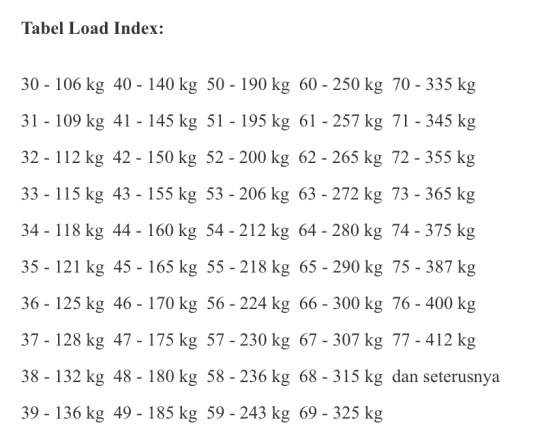
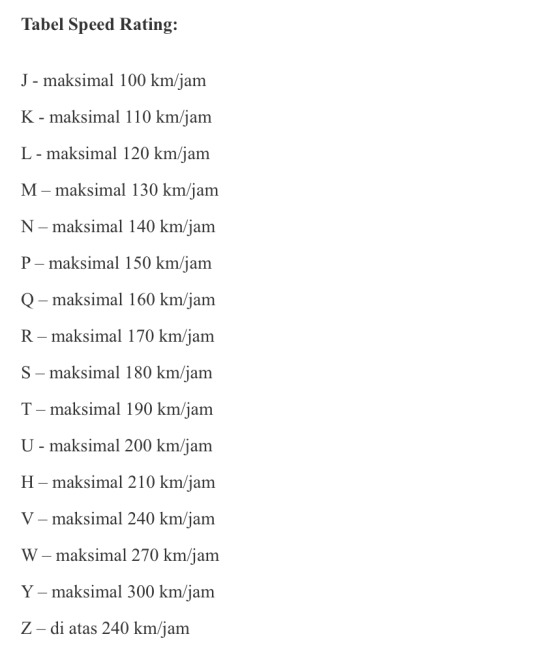
--
✅ Ganti minyak rem
➡️ Ciri-ciri : Bunyi saat rem Rem tidak pakem Warna minyak coklat tua/hitam Ganti sekali setahun
➡️ Akibat : Rem blong Kerusakan pada sistem rem; korosi, kebocoran, aus
➡️ Lokasi : Kotak kecil sebelah spion.
➡️ Produk : Perhatikan DOT (Department of Transportation)
Rata rata motor menggunakan DOT 3 (titik didih 205 derajat)
Gunakan DOT 4-5 untuk motor dengan berat atau power lebih tinggi.
DOT lebih tinggi : tidak pengaruh ke kepakeman rem.
DOT lebih rendah : mudah mendidih karena gesekan kampas rem dan disc brake. Menimbulkan uap air dan terjadi rem blong.
--
✅ Cek aki
➡️ Ciri-ciri : Mesin tidak bertenaga/lemah Starter sulit menyala Lampu mati/redup
➡️ Cara cek : Cek indikator kondisi air aki, bandingkan dengan level di boks aki. Cek ketegangan listrik menggunakan voltmeter.
➡️ Lokasi : Tergantung motor. Ada yang di bawah jok/kap mesin/samping mesin.
➡️ Produk : Spesifikasi, kapasitas, dimensi aki harus sama dengan aki bawaan.
Aki kering : maintenance free Aki basah : gampang tumpah/berkurang.
--
✅ Filter udara
➡️ Ciri-ciri : Tarikan mesin berat Boros bensin Cek 3 bulan sekali. Bersihkan atau ganti jika parah
➡️ Lokasi : Bagin paling atas mesin.
--
✅ Filter bensin
➡️ Ciri-ciri : Terhambatnya aliran bensin Mogok Kotoran dapat membuat tangki karatan
➡️ Lokasi : Antara tangki bensin dan mesin.
➡️ Cara membersihkan : Jika berwarna kecoklatan semprot dengan carburetor cleaner
Merendam dengan bensin baru
--
✅ Penggerak akhir (rantai/belt/shaft)
➡️ Ciri-ciri : Suara berisik Laju sulit diatur Perpindahan gigi kasar Permukaan penggerak akhir aus 15.000 km Berkarat Perputaran tersendat
➡️ Lokasi : Antara transmisi dan roda
➡️ Cara merawat : Gunakan pelumas/oli rantai Perhatikan posisi (selalu setel tengah, ada baut untuk mengencangkan/merenggangkan) Gunakan gear berkualitas dan orisinil (sesuai driving style) Mencuci setelah hujan Jangan gunakan pelumas/oli bekas
0 notes
Text
Wheels, Tyres, Brakes
Wheels are circular components of a motorcycle that support the weight of the bike and rider while allowing movement.
The System :
Motorcycle wheels provide support for the bike and rider while also transferring power from the engine to the road. The tyre grips the road surface, allowing the motorcycle to accelerate, brake, and turn safely. Spokes and rim provide strength and flexibility, absorbing shocks from uneven road surfaces. The hub and axle connect the wheel to the motorcycle's frame and suspension, allowing it to rotate freely while maintaining stability.
These are the schematics of Cbr1100xx Superblackbird 1997 (v) USA California.
Front Wheel Parts :

Weight Balancer Helps balance the wheel to prevent wobbling and ensure a smooth ride.
Rim Valve Allows for inflation and deflation of the tire, maintaining proper tire pressure.
Axle Connects the wheel to the motorcycle's frame, allowing it to rotate freely while supporting the bike's weight.
Right Collar Hold the wheel securely in place on the axle, preventing it from sliding side to side.
Left Collar
Axle Collar Supports the axle and helps keep it aligned properly within the wheel hub.
Wheel Provides support and stability for the motorcycle, allowing it to roll smoothly.
Tyre Made of rubber, it grips the road surface to provide traction and control.
Disk A metal disc mounted to the hub, used for braking by applying friction with brake pads.
Disk
Disk Bolt Secures the brake disk to the hub, ensuring it stays in place during braking.
Axle Bolt Fastens the axle to the motorcycle's frame, keeping the wheel securely attached.
Bearing Radial Ball Allows the wheel to spin smoothly around the axle, reducing friction.
Dust Seal Protects the bearings from dust, dirt, and moisture, prolonging their lifespan and ensuring smooth operation.
Rear Wheel Parts :

Sprocket Connects to the wheel and transfers power from the engine to the rear wheel via the chain.
Damper Absorbs shocks and vibrations from the road, providing a smoother ride.
Axle Connects the wheel to the motorcycle's frame, allowing it to rotate freely while supporting the bike's weight.
Brake Collar Holds the brake components securely in place on the wheel, ensuring effective braking.
Wheel Collar Supports the wheel and helps keep it aligned properly within the wheel hub.
Axle Sleeve Provides additional support and stability to the axle, reducing friction and wear.
Flange Sub-Assembly Reinforces the wheel assembly, providing strength and stability.
Axle Collar Supports the axle and helps keep it aligned properly within the wheel hub.
Wheel Sub-Assembly Forms the structure of the wheel, supporting the tire and providing stability.
Weight Balancer Helps balance the wheel to prevent wobbling and ensure a smooth ride.
Tyre Made of rubber, it grips the road surface to provide traction and control.
Valve Allows for inflation and deflation of the tire, maintaining proper tire pressure.
Disk A metal disc mounted to the hub, used for braking by applying friction with brake pads.
Bolt Fastens components together securely, ensuring they stay in place during operation.
Nut Secures bolts in place, preventing them from loosening over time.
Flange Nut Similar to a regular nut but with a wider base for added stability.
Washer Distributes the load of the bolt or nut over a wider area, reducing stress on the components.
Washer
Oil Seal Prevents oil from leaking out of the wheel assembly, ensuring proper lubrication and preventing contamination.
Bearing Radial Ball Allows the wheel to spin smoothly around the axle, reducing friction.
Bearing Radial Ball
Dust Seal Protects the bearings from dust, dirt, and moisture, prolonging their lifespan and ensuring smooth operation.
O Ring Forms a seal between components to prevent fluid or gas leakage.
Stud Bolt Provides a threaded connection point for attaching other components to the wheel assembly.
--
Spokes

Spoke Measurement

--
Types of Wheels

1. Spoked/Wire Wheels :
Pros : Classic look, great for off-road riding, easier to repair if damaged.
Cons : Heavier than alloy wheels, require more maintenance to keep spokes tightened.

2. Alloy Wheels :
Pros : Lightweight, offer better handling and performance on-road, require less maintenance.
Cons : Can be more expensive to repair if damaged, may not withstand off-road conditions as well as spoked wheels.

3. Magnesium Wheels :
Pros : Lightweight like alloy wheels, strong and durable, easy to clean.
Cons : Limited design options compared to spoked wheels, may be more expensive.

4. Carbon Fibre Wheels :
Pros : Extremely lightweight, provide excellent performance and handling, absorb road vibrations.
Cons : Very expensive, may require specialised maintenance, limited availability for certain bike models.
--




0 notes
Text
Final Drive
The final drive is the last part of the power transfer system in a motorcycle, transferring power from the gearbox to the rear wheel.
Components :

Types :


0 notes
Text
Engine (part 2)
Air Filters
Function : Air filters clean the air entering the engine, preventing dirt and debris from causing damage and ensuring a proper air-to-fuel ratio. Location : Typically found in the air intake system, often within the airbox or directly attached to the throttle body.
Importance : Protects the engine from contaminants. Maintains optimal performance and fuel efficiency. Maintenance : Regular cleaning or replacement is essential to prevent reduced airflow and maintain engine health.
Types of Air Filters :

1. Cotton Air Filters :
Descriptions : Cotton air filters are made from layers of cotton gauze, providing a porous and effective filtration medium. They are commonly used in automotive air intake systems.
Pros :
Improved Airflow : Cotton filters often allow better airflow compared to other types.
Reusability : Many cotton filters are washable and reusable, reducing long-term costs.
Enhanced Filtration : Effective at trapping particles while maintaining good airflow.
Cons :
Initial Cost : May have a higher upfront cost compared to basic paper filters.
Maintenance : Requires periodic cleaning and re-oiling.

2. Foam Filters
Descriptions : Foam air filters are made of foam material and are widely used in off-road and dirt biking applications due to their ability to handle dust and debris.
Pros :
Dust Resistance : Excellent at trapping dust and fine particles.
Durable : Resistant to damage from moisture and oil.
Suitable for Off-Road : Often preferred in off-road vehicles due to their durability.
Cons :
Restrictive to Airflow : May impede airflow more than cotton filters.
Limited Reusability : Reusable to an extent but may not last as long as cotton filters.

3. Paper Filters
Descriptions : Paper air filters, often made of cellulose, are among the most common types. They are found in many stock air intake systems.
Pros :
Cost-Effective : Generally more affordable than some other types.
Effective Filtration : Good at trapping particles and providing basic engine protection.
Low Maintenance : No cleaning required; easy replacement.
Cons :
Limited Lifespan : Typically not reusable and must be replaced.
Airflow Restriction : May restrict airflow more compared to cotton filters.
--
Fuel Pumps
The fuel pump's job is to send fuel from the fuel tank to the engine, ensuring the engine gets the right amount of fuel for driving.
Location : Located inside the fuel tank. This placement helps in efficient fuel delivery to the engine, contributing to overall performance.
Maintenance : Regular inspection of fuel lines for leaks or damage is crucial. Electric fuel pumps may require periodic checks or replacement if issues arise.
Types of Fuel Pumps

1. Mechanical Fuel Pump
Characteristics : A mechanical fuel pump is driven by the engine's camshaft or another mechanical linkage. It uses this mechanical action to pump fuel from the gas tank to the engine.
Pros :
Simple Design : Mechanical pumps are often straightforward in design.
Reliability : They don't rely on electrical components, making them less prone to electrical failures.
Cons :
Limited Pressure : May struggle to provide high fuel pressure, limiting their use in certain high-performance applications.
Engine-Driven : Can contribute to additional load on the engine.

2. Electric Fuel Pump
Characteristics : An electric fuel pump uses an electric motor to pressurise and deliver fuel from the tank to the engine.
Pros :
High Pressure : Electric pumps can provide higher fuel pressure, making them suitable for high-performance engines.
Versatility : Easier to install in various locations in the vehicle.
Fuel Regulation : Can be controlled more precisely.
Cons :
Electrical Dependency : Susceptible to electrical issues.
Complexity : Generally more complex than mechanical pumps.
Potential Overheating : May overheat under certain conditions if not adequately cooled.
--
Fuel Line

Function : Fuel lines are conduits that transport fuel from the fuel tank to the engine, ensuring a consistent and controlled flow of fuel.
Location : Extends from the fuel tank to the engine, running along the motorcycle's frame or within designated channels.
Materials : Constructed from materials resistant to corrosion and fuel deterioration, such as rubber, nylon, or stainless steel.
Types : Metal Lines : Some motorcycles feature metal fuel lines, often stainless steel, known for durability. Rubber/Nylon Hoses : More common, flexible, and resistant to vibrations.
Connectors and Fittings : Equipped with connectors and fittings to join sections and interface with components like the fuel pump and injectors.
Importance : Ensures a continuous and reliable fuel supply to the engine for combustion. Vital for maintaining proper fuel pressure and supporting engine performance.
Maintenance : Regular inspection for leaks, wear, or damage is crucial. Replacement of damaged or aging fuel lines is essential to prevent fuel system issues.
--
Cooling Systems
Cooling systems in vehicles are designed to regulate and maintain the temperature of the engine to ensure optimal performance and prevent overheating.


Types of Cooling Systems :

1. Air Cooling : How it works : Relies on the flow of air over engine components to dissipate heat. Common in : Some motorcycles and smaller engines. Location : Fins on the outside of the engine parts, like cylinder heads. Air cools them directly. Pros : Lightweight, simple design. Cons : Less effective under heavy loads.
2. Oil Cooling : How it works : Uses engine oil as a coolant, circulating it through the engine to absorb and dissipate heat. Common in : Motorcycles and high-performance vehicles. Location : Integrated into the engine, often near the engine block. Cools using circulating engine oil. Pros : Improved cooling compared to air cooling alone. Cons : Relies on the oil's heat dissipation capacity.
3. Liquid Cooling : How it works : Utilises a liquid coolant (usually a mixture of water and antifreeze) to absorb and transfer heat away from the engine. Common in : Modern cars, high-performance motorcycles, and various vehicles. Location : Radiator at the front of the vehicle. Cools with a liquid (usually water and antifreeze) circulating through the engine. Pros : Efficient heat dissipation, precise temperature control. Cons : More components and weight.

Radiators and Cooling Fins : How they work : Radiators are heat exchangers that release heat from the coolant to the air. Cooling fins increase surface area for better air cooling. Location : Radiator at the front of the vehicle. Fins on engine parts. Both release heat into the air. Pros : Efficient heat dissipation. Cons : Adds weight and complexity, requires regular maintenance.
--
Exhaust Systems

Functions :
Gas Expulsion: Releases burned gases from the engine.
Noise Reduction: Quiets the high-pressure gas noise.
Emissions Control: Converts pollutants into less harmful substances.
Back Pressure Management: Optimizes engine performance.
How It Works :
Exhaust Manifold : Gases move from cylinders to the exhaust manifold.
Catalytic Converter : Converts pollutants in the gases.
Muffler and Resonator : Reduce noise.
Tailpipe : Gases exit to the atmosphere.
Optional : Oxygen Sensors, EGR Valve : Monitor air-fuel ratio and recycle exhaust gases.
Exhaust Parts
1. Manifold :
Function : Collects exhaust gases from the engine's cylinders and channels them into a single pipe, aiding in efficient exhaust flow.
2. Catalytic Converters :
Function : Reduces harmful emissions by converting pollutants in exhaust gases into less harmful substances through chemical reactions.
3. Oxygen (O2) Sensors :
Function : Monitors the level of oxygen in the exhaust gases, providing feedback to the engine control unit for optimal fuel-air mixture.
4. Exhaust Pipes :
Function : Connects the manifold to other exhaust components, guiding exhaust gases toward the mufflers or other treatment devices.
5. Mufflers/Silencer :
Function : Reduces the noise produced by exhaust gases as they exit the engine and may influence backpressure for performance considerations.
6. Resonator :
Function : Mitigates certain frequencies of sound in the exhaust system, contributing to noise reduction and tuning the exhaust tone.
7. Tail Pipe :
Function : Directs treated exhaust gases out of the vehicle and away from the engine compartment.
8. Gaskets/Clamps :
Function : Seals the joints between exhaust components, preventing leaks and ensuring proper functioning of the exhaust system.
Exhaust Types
Single/Drag/Straight Exhaust Pipe :
Characteristics :
Consists of a single, straight pipe.
Typically used in custom or drag racing bikes for a minimalist appearance.
Pros :
Simplistic design for a clean look.
May contribute to weight reduction.
Can enhance the overall aesthetic of the bike.
Cons :
Limited impact on performance compared to more complex systems.
May lack some of the performance gains of multi-pipe designs.
Separate Dual Exhaust Pipes :
Characteristics :
Two separate exhaust pipes, each connected to its own cylinder or bank of cylinders.
Pros :
Balanced appearance.
Potential for improved exhaust scavenging.
May offer a unique sound profile.
Cons :
Adds weight due to duplicated components.
Complexity increases manufacturing and installation costs.
Four-Into-One Exhaust Pipe :
Characteristics :
Combines exhaust gases from four cylinders into a single pipe.
Pros :
Improved exhaust scavenging for potential performance gains.
Streamlined appearance.
May provide a unique exhaust note.
Cons :
Design complexity.
More intricate manufacturing.
May not suit all bike styles.
Slip-On Exhaust :
Characteristics :
Replaces only the muffler portion of the exhaust system.
Easier to install compared to a full exhaust system replacement.
Pros :
Affordability compared to a full system.
Provides a moderate increase in sound.
Quick and simple upgrade.
Cons :
Limited impact on overall performance.
May not offer as significant gains as a full system.
--
Ignition Systems

Ignition systems coordinate the precise timing of spark plug firing, ensuring efficient combustion for optimal engine performance. Components like spark plugs, ignition coils, CDI, and timing advancements contribute to reliable and controlled ignition processes.

Mechanical Points
Center Shaft : The central rotating shaft, often driven by the engine, spins at engine speed. 90-Degree Rocker Arms : Two rocker arms positioned at a 90-degree angle on the center shaft. These rocker arms are responsible for opening and closing the electrical circuit. Switch : The switch, in this context, refers to the set of mechanical points that make or break the electrical circuit. Each rocker arm operates its own set of points. Circuit Operation : As the center shaft spins, the 90-degree rocker arms open and close the switches alternatively. When closed, the switch completes the electrical circuit, allowing current to flow to the ignition coils. Ignition Coils : The ignition coils receive the current from the closed switches. When the circuit is broken, the collapsing magnetic field in the ignition coil induces a high-voltage spark. Spark : The high-voltage spark is then sent to the spark plugs, initiating combustion in the engine cylinders.
1. Spark Plugs :

Characteristics : Small, threaded components in the cylinder head.
Function : Ignite the air-fuel mixture for combustion.
Importance : Essential for engine startup and performance.
Maintenance : Regular replacement ensures optimal function.
2. Ignition Coils :

Characteristics : Electrical components converting low voltage to high for spark plugs.
Function : Produce high-voltage sparks to initiate combustion.
Importance : Enhance reliability and consistent combustion.
Maintenance : Can fail over time due to heat and electrical stress.
3. CDI (Capacitor Discharge Ignition) :

Characteristics : System storing and releasing electrical energy for ignition.
Function : Quick, precise spark timing suitable for high-revving engines.
Application : Common in motorcycles and small engines.
Considerations : Sensitive to electrical issues, replacement can be complex.
Timing Advancements :
Characteristics : Adjustments to spark plug firing timing.
Function : Optimise combustion for efficiency and power.
Benefits : Improved fuel efficiency, reduced emissions, and stress.
Considerations : Complex systems may require careful maintenance.
Electron Ignition
Electronic Ignition is a modern way to start a car or motorcycle engine. Instead of old-fashioned parts that can wear out, it uses electronic pieces to make sure the engine starts smoothly and runs efficiently. It's like an upgraded and more reliable version of the ignition system in vehicles.
TCI (Transistor Controlled Igniter) and CDI (Capacitor Discharge Igniter)


Capacitor Discharge Ignition

CDI makes engines start quickly and work well.
It uses a strong spark at just the right time.
It's small, easy to use, and good for fast engines.
No old parts to worry about, and it works in different places.
It helps engines run cleanly and gets ready for the next spark fast.
Transistor Controlled Igniter

A Transistor-Controlled Igniter is like a smart helper for engines.
It uses transistors to control when sparks happen, making engines start and run better.
It's an upgrade that's more reliable and needs less fixing.
0 notes
Text
Engine (part 1)
Powers the motorcycle.
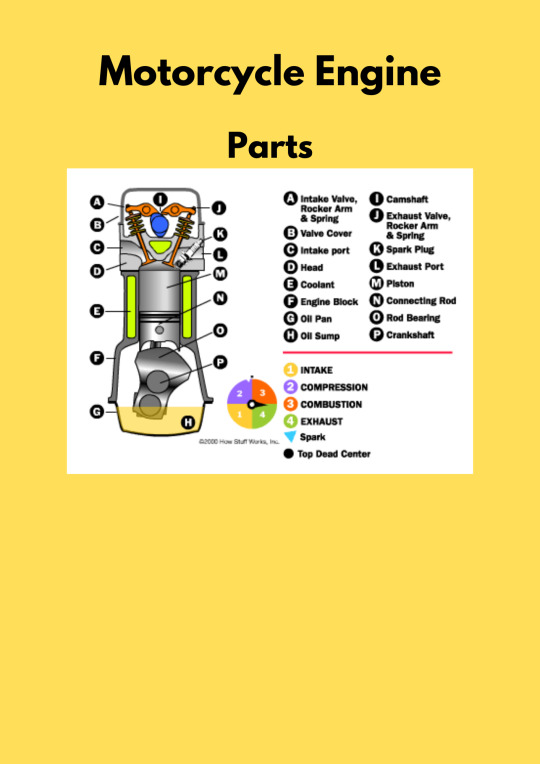
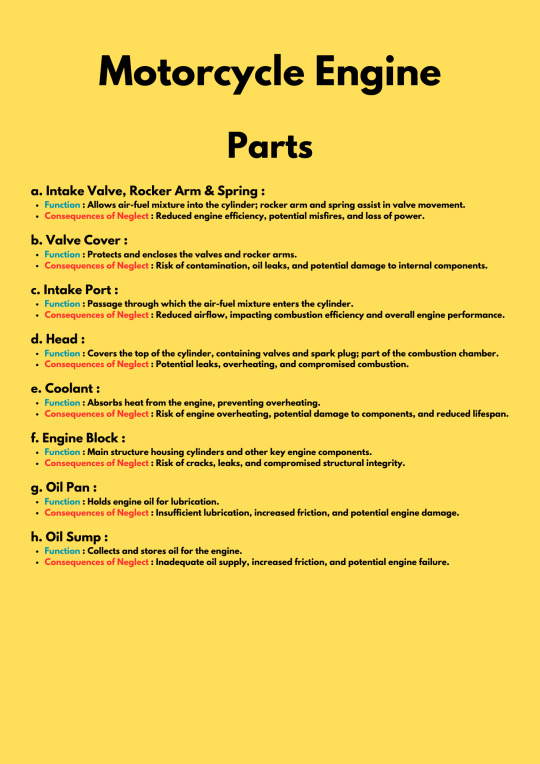

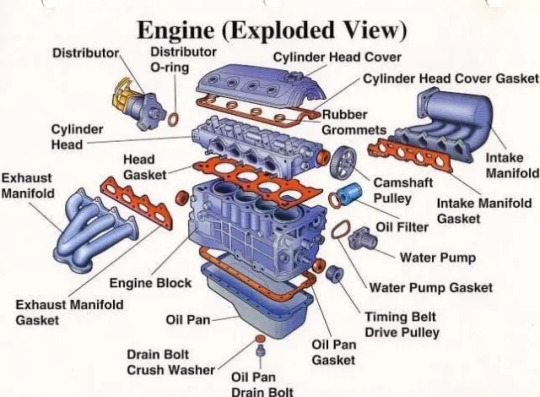
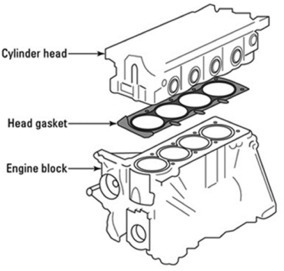
Functions :
Cylinder Head :
Combustion chamber of the engine.
Location for installing spark plugs.
Site for distributing lubricating oil.
Place for valve mechanisms.
Intake and exhaust passages.
Location for circulating coolant.
Region for the water jacket flow.
Head Gasket :
Oil leak prevention and seal maintenance from cylinder block to head.
Compression support for combustion.
Pressure containment to prevent spreading from cylinder block to head.
Heat management from cylinder block to head.
Cylinder Block :
It gives a cozy home for the piston to move up and down smoothly.
Directs the power made during combustion to push the piston.
Helps the crankshaft (a part that turns motion into rotation) do its job.
Acts like a highway for coolant, keeping things cool.
Creates a path for oil to keep the engine running smoothly.
Acts as the main hub for engine parts to chill together.
Keeps the engine's ID (serial number) in a safe place.
Provides a space for fuel to ignite and power up the engine.
Supports important parts like cylinder liners, cylinder head, and flywheel, making the engine work like a charm.
--
Valve Mechanisms
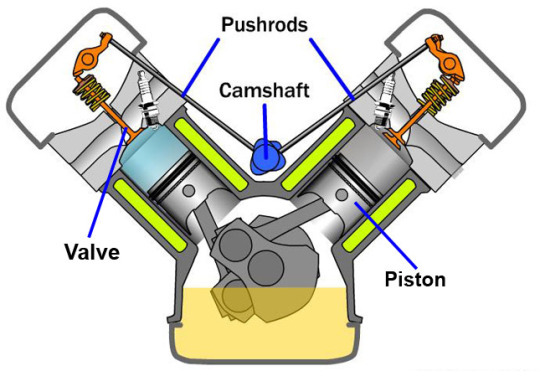
2 Types of Valves :
Intake Valve :
Location : Top of the cylinder.
Function : Controls the air and fuel going into the engine.
Importance : Makes sure clean air and fuel get inside the engine.
Exhaust Valve :
Location : Side or bottom of the cylinder.
Function : Manages the exit of used gases from the engine.
Importance : Helps get rid of the stuff the engine doesn't need anymore.
Functions of Valves :
Managing the Fuel-Air Mix : The intake valve controls how the air and fuel blend enters the cylinders, kicking off the combustion process. This shapes the motorcycle's power and overall performance.
Clearing Used-up Gases : The exhaust valve directs the removal of burnt gases from the cylinders, preventing the build-up of exhaust gases inside the engine and improving how efficiently the motorcycle runs.
Types of Valves :
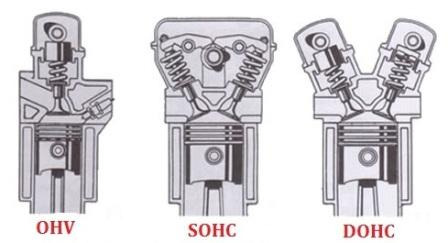
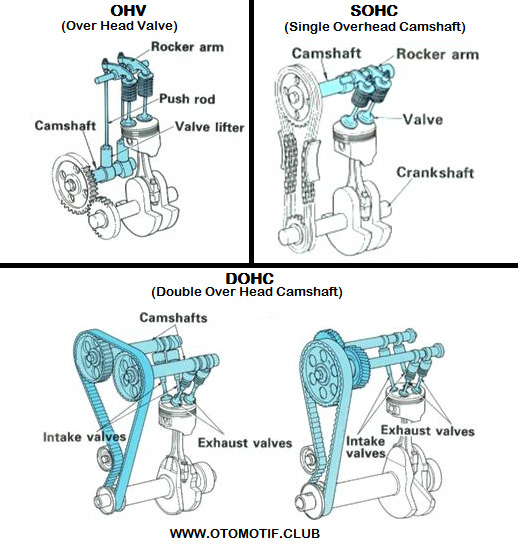
source : rangkumanmesinotomotif.blogspot.com source : Facebook - Otomotif.Club
OHV (Over Head Valve) :
Characteristics : 1. Simple design with the camshaft located near the crankshaft. 2. Uses push rods to operate the valves. 3. Often found in smaller engines like lawnmowers and some older vehicle designs. Pros : 1. Cost-effective to manufacture. 2. Compact design, suitable for smaller engines. 3. Generally, reliable and durable. Cons : 1. Limited in high-performance applications. 2. Less precise valve control compared to DOHC. 3. Typically, not as fuel-efficient as more modern designs.
SOHC (Single Overhead Camshaft) :
Characteristics : 1. Uses a single camshaft placed in the engine head. 2. The camshaft controls both intake and exhaust valves through rocker arms or similar mechanisms. 3. Commonly used in a variety of vehicles. Pros : 1. More efficient than OHV in terms of valve control. 2. Provides a good balance between performance and cost. 3. Suitable for everyday use and a wide range of applications. Cons : 1. Generally less powerful than DOHC engines. 2. Limited in high-performance applications. 3. May not offer as precise valve timing as DOHC.
DOHC (Double Overhead Camshaft):
Characteristics : 1. Uses two camshafts, one for intake valves and one for exhaust valves. 2. Camshafts are typically located in the engine head. 3. Allows for precise valve timing and control. Pros : 1. Excellent valve control, leading to better performance. 2. Suitable for high-performance vehicles. 3. Can achieve higher engine speeds and power output. Cons : 1. More complex and expensive to manufacture. 2. Requires more maintenance. 3. Generally not as fuel-efficient at lower speeds compared to SOHC.
--
Types :
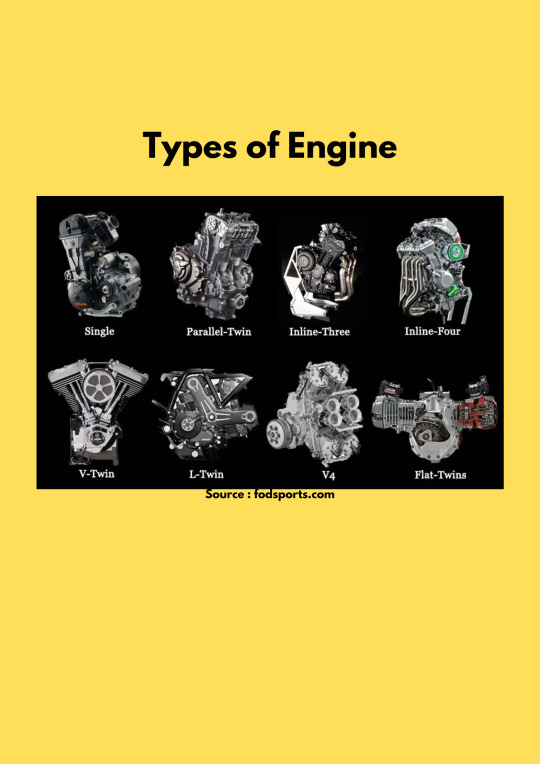
Note : There are more than 8 types. These eight are the most common engines.
Single Engine :
Description : A single-cylinder engine has only one cylinder. Pros : Simple design, lightweight, and cost-effective. Cons : Vibrations, less power compared to multi-cylinder engines.
Function : Simple, lightweight design suitable for basic transportation. Motorbike Example : Honda CRF230F.
Parallel-Twin Engine :
Description : Two cylinders arranged parallel to each other. Pros : Compact size, good torque at lower RPMs. Cons : Moderate vibrations, less smooth than inline-four.
Function : Balanced performance with good torque, suitable for various riding styles. Motorbike Example : Yamaha MT-07.
Inline-Three Engine :
Description : Three cylinders arranged in a line. Pros : Balance of power and fuel efficiency, smoother than a single. Cons : Slightly more complex than a twin, but less than a four.
Function : Balances power and fuel efficiency, providing a smooth ride. Motorbike Example : Triumph Street Triple.
Inline-Four Engine :
Description : Four cylinders in a line. Pros : High power, smooth performance, well-balanced. Cons : Larger size, complexity, and potential for more weight.
Function : High power and smooth performance, ideal for sport and touring bikes. Motorbike Example : Kawasaki Ninja ZX-6R.
V-Twin Engine :
Description : Two cylinders arranged in a V-shape. Pros : Strong torque, unique sound, compact. Cons : Can have uneven power delivery, may produce more heat.
Function : Strong torque, distinctive sound, suitable for cruisers and custom bikes. Motorbike Example : Harley-Davidson Sportster.
L-Twin Engine :
Description : Similar to a V-twin but with one cylinder vertical and the other horizontal. Pros : Good torque, unique configuration. Cons : Some uneven power delivery, more complex than a V-twin.
Function : Good torque with a unique configuration, often found in sport and touring bikes. Motorbike Example : Ducati Panigale V2.
V4 Engine :
Description : Four cylinders arranged in a V-shape. Pros : Good power and balance, smooth performance. Cons : Can be larger, more complex and costly to manufacture.
Function : Balances power and smoothness, suitable for sport and touring motorcycles. Motorbike Example : Honda VFR1200F.
Flat Twins (Boxer Engine) :
Description : Two cylinders arranged horizontally. Pros : Low center of gravity, smooth operation. Cons : Wider, potentially more complex design.
Function : Low center of gravity, smooth operation, often used in touring bikes. Motorbike Example : BMW R1250GS.
--
Cylinders
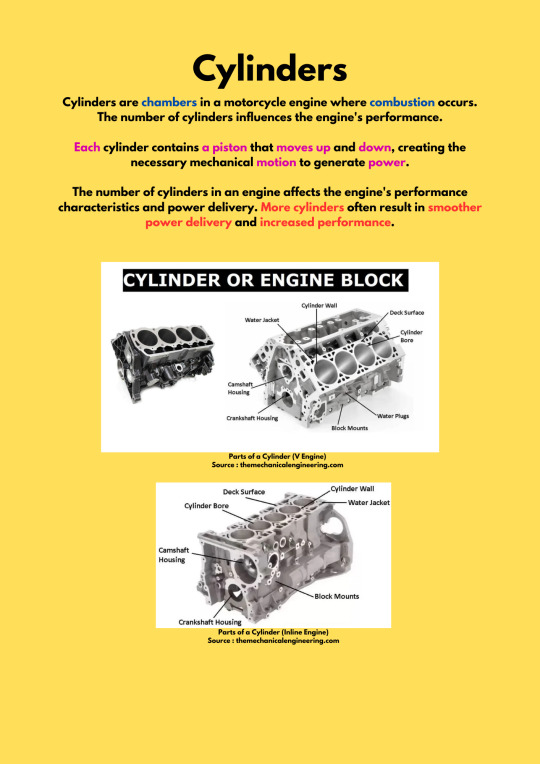
Engines & The Number of Cylinders :
Single CC Range : 50cc - 500cc
Twin : CC Range : 250cc - 2000cc Straight-Twin V-Twin Flat-Twin Tandem-Twin
Triple : CC Range : 600cc - 1200cc Inline-Three
Four : CC Range : 600cc - 2000cc Inline-Four Flat Four V4 Square Four
Five : CC Range : 1500cc+ V5
Six : CC Range : 1200cc - 1800cc Inline-Six Flat Six V8
--
Strokes
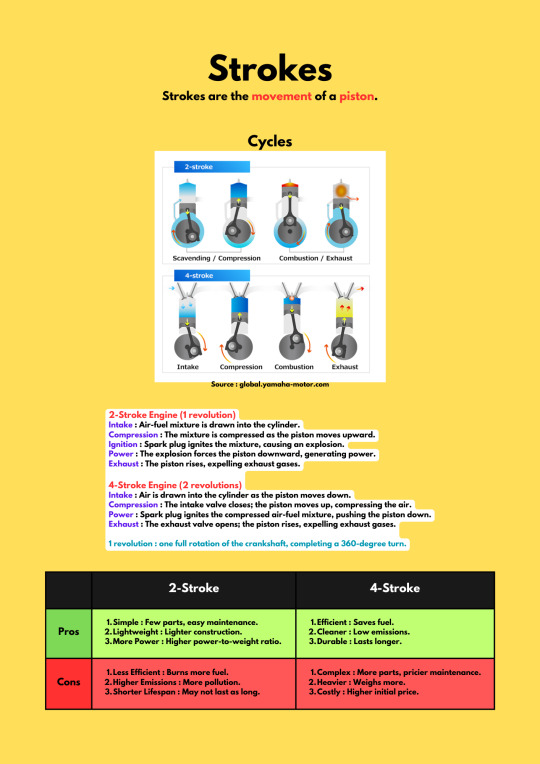
--
Engine Displacement
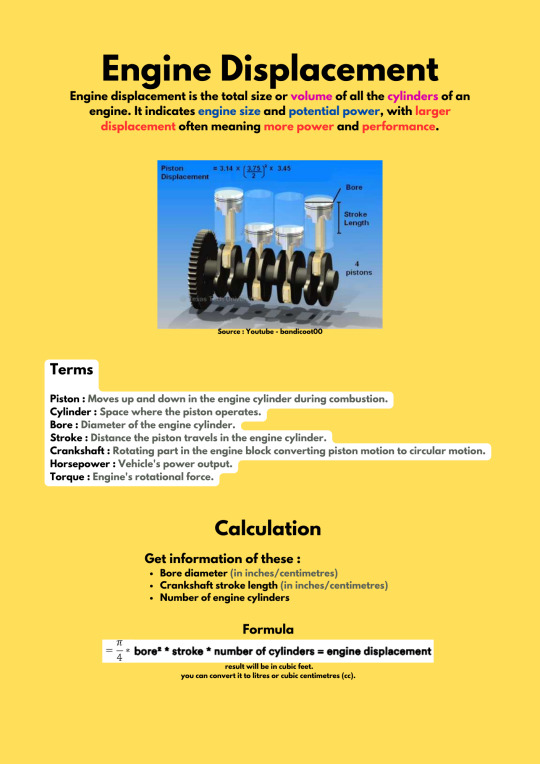
--
Fuel System
Fuel Delivery
Fuel delivery is the process of supplying fuel to the engine for combustion. It involves mechanisms like fuel injection or carburetion, ensuring the right fuel-air mixture for engine performance.
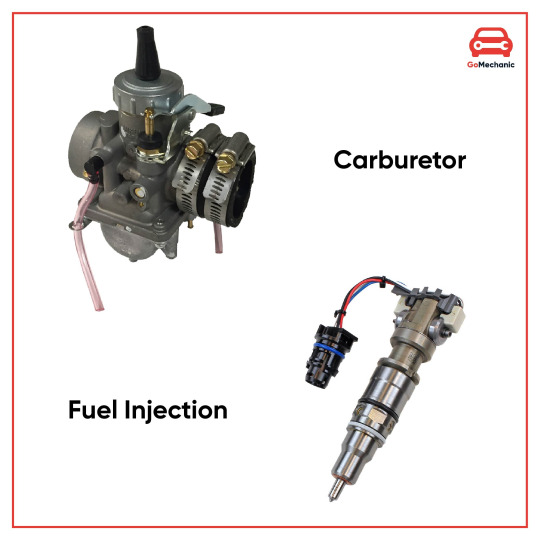
source : gomechanic.in
Types of Fuel Delivery :
1. Fuel Injection : What it is : Modern way of delivering fuel to the engine. How it works : Sprays precise amounts of fuel directly into the engine. Location : Fuel injectors near the intake manifold or in the engine; throttle body near the engine. Pros : More efficient, better control, usually cleaner emissions. Cons : Can be more complex and expensive. 2. Carburetion : What it is : Traditional method of mixing air and fuel. How it works : Uses a carburetor to blend air and fuel before entering the engine. Location : Carburetor usually on the side or top of the engine, connected to the intake manifold. Pros : Simplicity, lower cost. Cons : Generally less precise, potentially lower efficiency.
Throttle System
Controls the amount of air and fuel entering the engine, ultimately regulating the engine's power and speed.
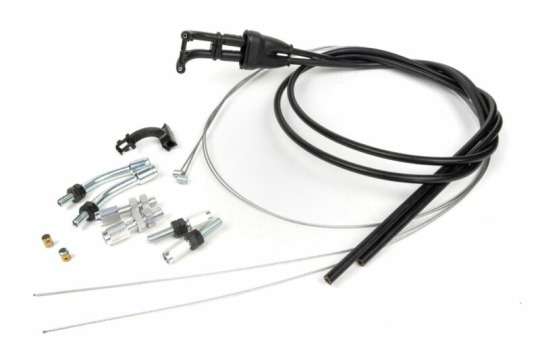
source : sanemotionmoto.com
Mechanical Throttle (by-Cable)
Operation : Utilises a physical cable to connect the throttle grip on the handlebar to the throttle valve in the carburetor or throttle body. Characteristics : Direct mechanical linkage. Responsive but may require periodic adjustments. Common in older motorcycles and some traditional or simpler models. Pros : Simplicity. Familiarity for riders accustomed to older bikes. Cons : May require more frequent adjustments. Limited integration with advanced electronic features.
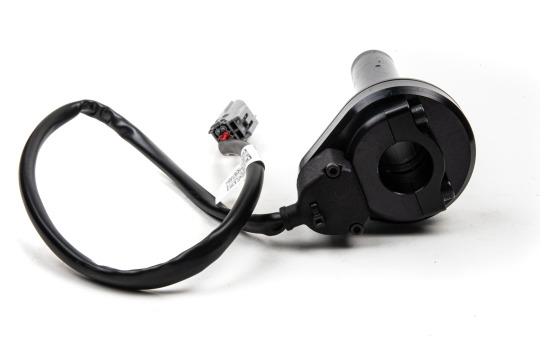
source : sanemotionmoto.com
Electronic Throttle (by-Wire)
Operation : Replaces the physical cable with electronic sensors and actuators that send signals to control the throttle valve. Characteristics : Offers more precise control. Integrates with advanced engine management systems. Can include additional features like cruise control and traction control. Pros : Enhanced control and responsiveness. Enables integration with modern electronic systems. Potential for additional functionalities. Cons : Complex electronic systems may be more challenging to troubleshoot or repair. Initial cost may be higher.
0 notes






